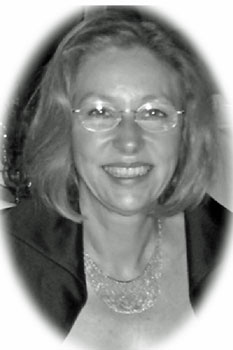Marcia Joslyn Scherer,
PhD, MPH, FACRM
Born: 9 June 1948,
Buffalo, NY

-
Entry into the AT field:
1976
-
How I got into the
field
I was working on my master's
degree in rehabilitation counseling at the same time as my husband was working
on his electrical engineering masters. He was reading about devices for people
with disabilities. The engineering articles were more glowing than the real
life experiences that he was hearing from me about technologies used by
consumers. He said, "Maybe you can do something about that."
-
Important event(s) that influenced
my early decision to get into the assistive technology field
See above.
-
Why I chose the AT
field
I started out in the mental
health field and was a psychotherapist. Talk about "living in the state of
stuck"! It was very frustrating to see how the system resulted in a
revolving-door situation for so many individuals. So I changed to working with
people with physical disabilities and hoping to help them achieve their dreams
and goals.
-
My inspiration and
mentor
Other than my husband, no. As
a female in a technical field, and a new field, there were, sadly, no mentors.
I formed good, close friendships with fellow colleagues, however, and that was
invaluable -- and is to this day. Thus, I thank my RESNA colleagues for being
so key to my work!
-
Why the field is important to me
and the central focus of my work
I
came from a psychology and rehabilitation background where the emphasis was on
helping consumers' articulate their goals and then helping them find ways to
achieve them. My NSF-supported dissertation study was researching differences
in consumer and therapist perspectives of quality of life, rehabilitation
success, and assistive technology use. That became the foundation of the book
Living in the State of Stuck and also the content for the Matching Person &
Technology Model and accompanying measures.
-
My memorable successes and
greatest contributions to the field
Having colleagues and their students adopt the
MPT Model and measures. This meant they actually read my work and want to work
with consumers in AT decision-making and appropriate AT selection. My greatest
contributions to the field are the texts I've written or edited, the journal I
edit, and the MPT process and measures. All were meant to encourage listening
to the voice of the consumer, getting to know the person, and working with that
person on goal achievement, inclusion/participation, and life quality.
-
My most memorable
failures
There are several that come
to mind. On occasion, I have taken on too much work for a period of time,
resulting in missed deadlines, etc. I learned to spend more time planning,
delegating, and getting better organized.
-
Significant changes and advances
in the field since I first entered it
We have always embraced an interdisciplinary,
international collaboration and I have seen this grow over the years. This
collaboration has resulted in products and services that better meet the needs
and preferences of consumers. Many rehabilitation disciplines are more focused
and specialized than ours and this has, on occasion, reduced their
effectiveness. Significant advances - the sheer variety of product choices,
which makes the AT selection process complex. I am happy to continue to make my
measures and writing more useful to professionals and consumers as this
complexity increases.
-
On the future of rehabilitation
engineering and assistive technology
High technology, complex systems, formal
protocols, being evidence-based and results oriented, more use of measures, and
so on. The future is especially bright because of the emphasis now on the
community participation of people with disabilities.
-
My role within RESNA and what it
gave back to me
RESNA was the
organization that stood behind my work at the outset. Thus, I have always
strived to enhance the organization. I am a past member of the Board of
Directors and started a new SIG (22) to focus on consumer perspectives of AT
and AT services. Without RESNA, my work would not be very well known or as
highly regarded.
-
On the future of RESNA
RESNA is the go-to organization for anyone
interested in AT. This needs to expand to more people and disciplines, and it
will.
-
My suggestions for those just
entering the field
I would recommend
that in order to develop career skills and stay current, they should regularly
attend relevant conventions and training opportunities. Be sure to spend time
networking with others in the field, and keep informed by reading both the
journals and books in the field. You will certainly meet many difficult
challenges in your career. Work hard and persist, however, as it is so worth
it!
|